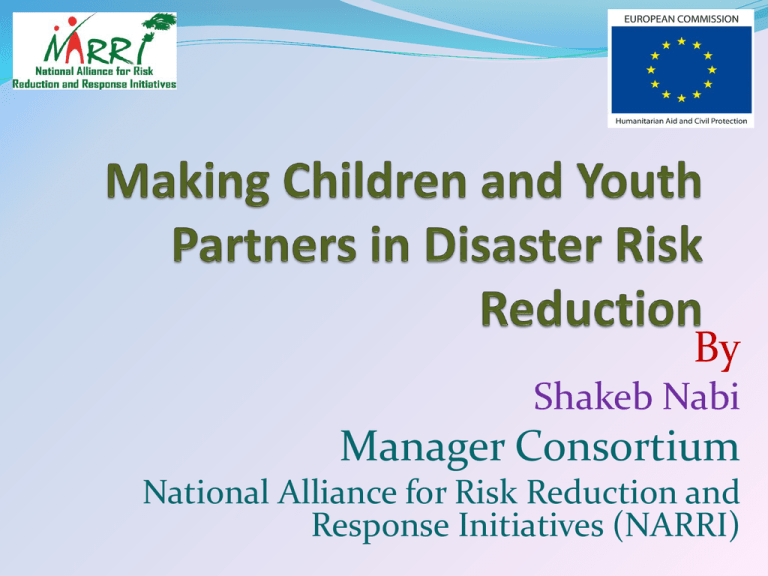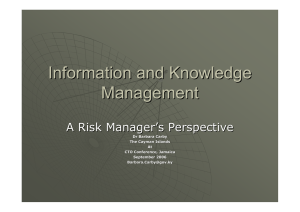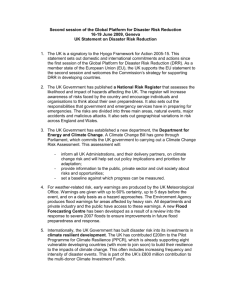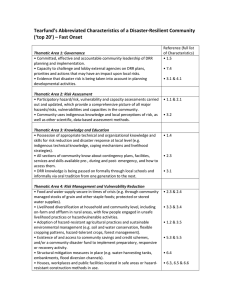Presentation IDDR
advertisement

By Shakeb Nabi Manager Consortium National Alliance for Risk Reduction and Response Initiatives (NARRI) Who is NARRI? It is a consortium of six INGOs working on Disaster Risk Reduction and Response in Bangladesh Who are the partners The Reason for Coming Together Different organizations working in isolation which brings in incoherence in the whole programming Enhance program quality Avoid duplication Learn from each other (capacity building of the local team) Form a big pressure group to influence policy Greater benefit to the community 1. The International Day for Disaster Reduction (IDDR) 13 Oct this year 2. This years theme: Making Children & Young People Partners in Disaster Risk Reduction … . FIVE POINT CHIDLREN’S CHARTER 3rd Session Global Platform 2011 1. Schools must be safe - education must be uninterrupted; 2. Child protection must be a priority, before, during and after a disaster; 3. Children have the right to participate and they need access to information 4. Community infrastructure must be safe, and relief and reconstruction must help reduce future risk; “Effective risk management must Natural hazards are increasing ‘children are among the most involve those most at risk” traumatized as their ability to cope Children and youth are repeatedly with unexpected and painful portrayed as victims of disaster and interruptions climate change. Children and youth can and should be Some 66 million children are affected by disasters every year. encouraged to participate in disaster risk Destroyed or damaged schools reduction and decision making” force children out of school. Malnutrition caused by the loss of food supplies cause stunting and lead to poor educational achievement and greater susceptibility to disease. The children’s Charter Schools must be safe - education must be uninterrupted. Child protection must be a priority, before, during and after a disaster. Children and young people have the right to participate and to access the information they need. Community infrastructure must be safe, and relief and reconstruction must help reduce future disaster risk. Disaster risk reduction must reach the most vulnerable. Involving Children and Youth Change in the whole thinking process and attitude (children can contribute to DRR at community and family level) Invisible --------- Visible Children and youth should not be considered homogenous sets (diversity within these groups) Recognize and promote children and youth’s contribution Contd…. Child friendly environment, tools and techniques Forming/recognizing children and young people organization (working with them) Groom children and youth as future leaders Involving Children and Youth will enhance the quality of program •Mind is pure •Bundle of energy •Willingness to do something for the society •Creativity Challenges Out of school children Some of the most vulnerable areas are very remote Access to rights and entitlements (education and health services) Demystify the concept DRR: It is a priority for the community? Is DRR a priority for the government? (category) New concept and evolving “Natural Hazards, Unnatural Disasters” (Haiti and Chile) what you can do (get involved).. Enlightened souls and ignited minds (torch bearer) First self-> Family -> Community -> larger goals Understanding of the issue from a practical perspective (lab to land) Techno-social solution From groups, clubs; involve with scouts, guides, NCC Promote a culture of safety Modern means of communication (social networking) For Further information please visit Website: www.narri-bd.org Facebook: NARRI Bangladesh Email: shakeb.nabi@actionaid.org Thank You











